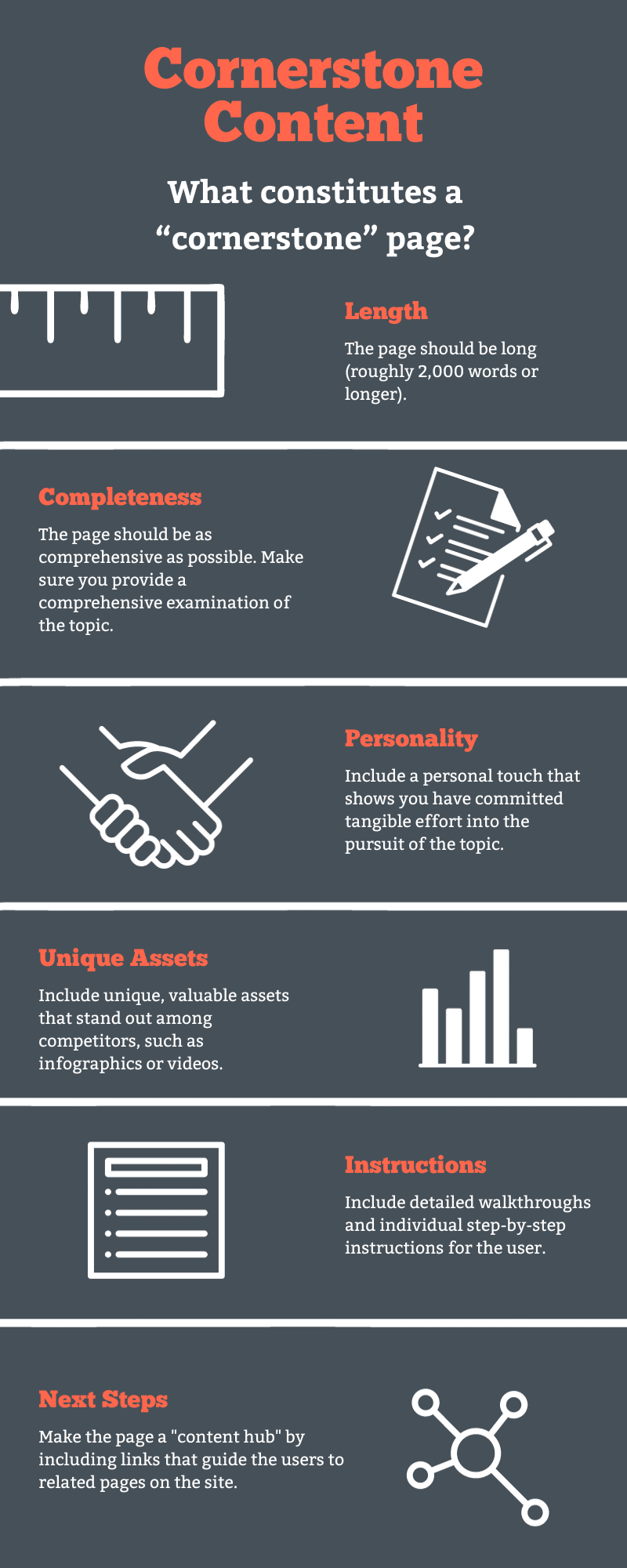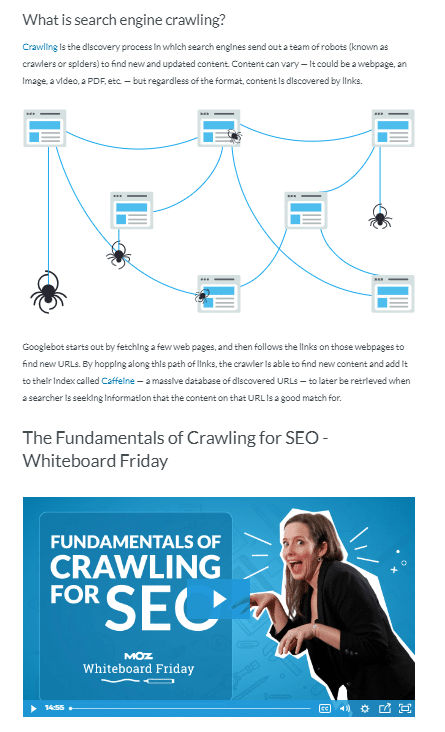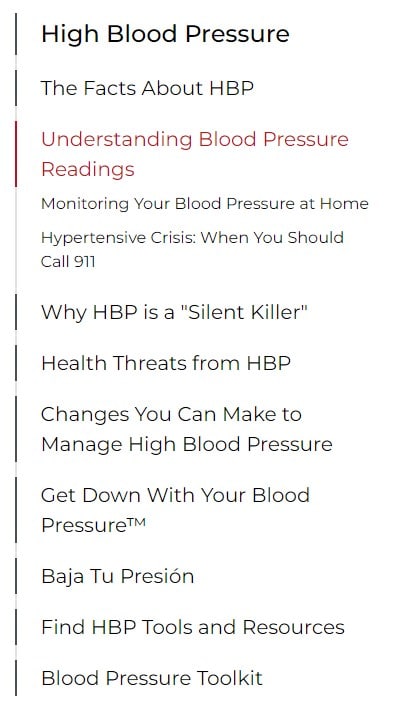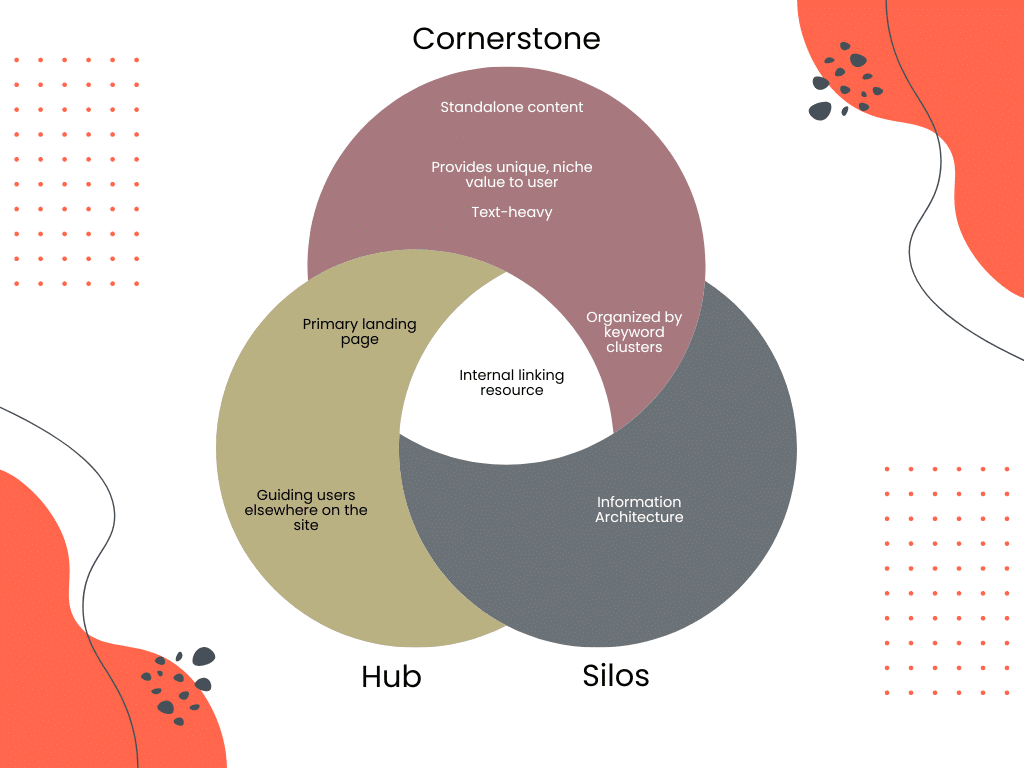Cornerstone content is defined as any kind of valuable content on your site that serves as a central piece of information for your target audience.
It should be comprehensive to the point of exhausting all user needs, while also having the breadth of diverging topics that would call for additional pieces of content stemming from this original page.
That is where the concept of ‘cornerstone’ comes in, as it establishes a solid foundational baseline and direction for the content, allowing for other ‘stones’ to extend in multiple directions relying on the cornerstone’s strength.
The publication of cornerstone content is very important if you want to become the voice of authority on any given topic. It drives home your expertise by providing incredible value to the user, and that earned expertise then allows you to create sub-topic pages that extend the concept further or take it in new directions. Any website hoping to develop an engaging and productive online presence should take the time to create cornerstone content that fully satisfies this definition.
Understanding Cornerstone Content

SEO specialists around the industry tend to vary slightly in their definition, but the root understanding is the same: cornerstone content needs to be strong and entirely fulfilling, providing the user with everything they could possibly need to know on the topic.
That usually entails:
- Length: A page long enough to fully paint the picture of your topic
- Thorough: Comprehensive examination of the topic
- Personal: Proof of personal touch, either through clear engaged work or author credentialing
- Unique-Value Assets: Inclusion of unique
pieces of content, whether that includes infographics, videos, or screenshots - Instructions: Detailed walkthroughs if applicable
- Content Hub: Internal links pointing to deeper pages related to the same topic
The concept of ‘cornerstones’ originates in construction, and dates back centuries. One large, strong stone would be used as the first stone in construction, which would act as a solid starting point to inform the rest of the construction going forward. The cornerstone is placed first, and all other pieces rely on the cornerstone to inform their direction, placement, and structure.
This definition applies to cornerstone content in two ways: In one sense, the building is the website/brand, and the strong pieces of content tend to drive most of the visibility and inform the brand personality. Think The Beginner’s Guide to SEO from Moz.
At the same time, the smaller bricks extending from the cornerstone content are sub-topic pages that only make sense in the context of the website because of the direction set by the cornerstone.
Real-World Examples of Cornerstone Content
Regardless of the industry, there are examples of websites that have used the tactic of cornerstone content and established themselves as voices of authority on their given topic. The three examples included below are:
- Moz: The Beginner’s Guide to SEO
- Johns Hopkins Medicine: Intermittent Fasting
- American Heart Association: Understanding Blood Pressure Readings
Each of the examples above fit the criteria from a data perspective, representing the most popular landing pages for each respective site in terms of organic visibility.
Additionally, they earn an exceptionally large number of backlinks since they provide that unique user value and are positioned as points of authority on the topic. The examples will be analyzed in terms of how they fit each point of criteria listed above.
Length: In terms of length, each of the example pages is exceptionally long.
The Moz example is broken out into seven chapters, each with their own page. In total, the word count is 36,393 words, which is extensive beyond belief. That is most likely why they divided the content into nine different pages (with the landing page and the glossary included).
You do not need to necessarily write over 35,000 words for the content to be considered extensive, but you do need to go above and beyond at all costs.
Thorough: In the Moz example, the writers have included so many different components of the topic, and yet have dedicated full effort to providing value for each one. For example, in the How Search Engines Operate chapter, there is a discussion on how to tell search engines how to crawl your site, which is one of eight subcategories on this page (<h2>). Within this subcategory, there are:
• 13 subheadings (either <h3> or <h4>)
• 1 Code snippet example
• 3 Custom graphics
• 1 table
• 12 links, both internal and external
With a total of 2,248 words total, this section could easily be its own standalone page that fully satisfies an entire subquery. And yet, it is only 30% of the entire page (7,269 words total).
Personal: In the example from Johns Hopkins Medicine, doctors that work for the hospital were cited with references to official studies and clinical trials. Additionally, quotes from those specialists were featured throughout to provide additional authority on the topic.
Unique-Value Assets: In the Moz example, there are videos and infographics peppered throughout the content, all created by Moz.
Each infographic and video provide unique value to the user, should they decide to watch the video or scan the infographic in its entirety.
At the same time, each asset also provides a more diverse range of material on the page, encouraging users to interact with whatever they may find the most useful. Finally, it establishes a breadth of experience, showcasing the fact that you have gone above and beyond in the creation of your own material.
Instructions: In the same Moz example, in the Technical SEO chapter, there are individual instructions on how to use Google Search Console to inspect a page and test a live URL. Step-by-step instructions are valuable from an SEO standpoint because you are providing clear and tangible support to the user. There is a clear a benefit to the user, and generally paints your page as exceptionally useful, as opposed to maintaining an informational tone.


Content Hub: In the example from the American Heart Association, there are two examples of that page acting as a content hub and linking to deeper related content. The side navigation links to two pages immediately below this page, with direct relevancy. There are eight additional subtopics under the parent topic of High Blood Pressure, and while they aren’t necessarily nested directly within this page topic, this page still functions a content hub. This is because users are significantly more likely to land on this page (794k organic monthly sessions) than the actual High Blood Pressure landing page (22.9k).
The second example is the list of related articles, which connects this page with the three most relevant posts from the blog.
Debunking Common Misconceptions: What Cornerstone Content is Not
The concept of cornerstone content has been conflated with other ideas or labeled something it is not in various instances around the Internet. Some equate it to something closer to technical SEO, while others have a very literal definition associated with the most visible pages on their site.
It is important to understand, at least in our definition, what cornerstone content is not, so we can more properly understand what it is.
Cornerstone Content vs. Content Hubs
A content hub is something that is often conflated with cornerstone content, and they admittedly do share some common elements despite there being several important differences.
A content hub is any collection of pages that users can sort through to find the exact content they are looking for. A common example of a content hub is a blog landing page. This type of page might house some unique content of its own,
but the primary purpose is to link to individual pages with a list but also with other functionality such as featured items, dropdown filters and a search bar.
The important difference between the two is that cornerstone content is a standalone piece of work that happens to link to sub-pages and other portions of the site. The immense value of the page naturally lends itself to linking around the site to relevant places, but at its core the page stands alone.
Cornerstone Content vs. Content Silos
Cornerstone content and content silos may sound similar, but one is a literal page, while the other is a method of site organization from an SEO perspective.
Content silos are segments of your website that have been organized around strategic focal points, most commonly high-volume keyword groups. The process is closely connected to the work of an information architecture, organizing the site in a user-friendly manner while also highlighting the most important elements of the website from an SEO standpoint.
A piece of cornerstone content may exist at the head of a content silo, serving as the central piece of a siloed portion of the site.

Why Google Loves Cornerstone Content
While it will serve value directly to the user, cornerstone content also serves an important role in the eyes of search engines. This style of content is very valuable in terms of E-E-A-T (Expertise, Experience, Authoritativeness, and Trust). Each element of this search guideline is fulfilled through effective cornerstone content:
- Expertise: Inclusion of in-house experts with cited sources
- Experience: The writer showcases actual experience with the product or service, showing proof of unique work
- Authoritativeness: By providing high-value, comprehensive work through cornerstone content, the site establishes its own authority on a given topic
- Trust: If the work is thorough and there are quality sources throughout, an immense amount of trust can be built on the quality of the content alone
As we have mentioned already, the user experience of a site is also improved through the effective use of content development. In providing an entirely thorough and comprehensive product, the user feels fulfilled after reading through the page. Additionally, by linking around the site to the best next steps, you are giving the user clear opportunities to navigate to exactly what they are looking for next.
You can see the effectiveness of cornerstone content in your data over time, in several ways. For one, your content will begin to obtain significant organic visibility, rising up in session count to become one of your most popular pages. Additionally, your bounce rate should decline and time on site should improve as users find your site more valuable as a whole.
Once the page has had time to marinate and settle into the search landscape, you will also see an exceptional number of backlinks, as the content is so valuable and useful that other sites will begin referencing and pulling from it.
Creating Cornerstone Content
The creation of cornerstone content begins well before the content itself is written. There should be thorough planning as well as considerable amount of research ahead of the writing process. Only when you feel fully familiar with the topic and confident in your own abilities to speak on it will you be prepared to begin writing.
1. Identify Your Target Audience and Goals
The identification of your target audience is the foundational work required before any other work can be done. You need to understand who you are speaking to, as well as what they are hoping to obtain from this page. The end goal is for the content to fully satisfy your target user, so understandably the first step should be a proper identification of that user.
Identifying your target user is no easy task, as it requires extensive research among peers, market analysis, and keyword research.
To begin, build a ‘universe of keywords,’ a wide-ranging collection of keywords that share a general semantic relationship and could collectively exist on a piece of cornerstone content. From that list of keywords, identify the most common questions as well as the most common user pain points. This can come from the People Also Ask SERP segment, longtail keyword research, and rich snippets in search results.
The keyword research alone will tell you the user pain points and their most prominent objectives, and from there you can paint the picture of what an ideal user arriving to your site looks like. That will become immeasurably valuable in each remaining step.
2. Choose the Right Topic
Now that you understand your user base and are prepared to talk to them directly, it is time to decide on the specific topic you will be addressing. The topic should fulfill several elements in order to be the right fit:
- It should have high search volume
- There should be plenty of longtail keywords that could stem from that topic and serve as individual piece of content on the page or elsewhere on the site
- It should be something that fits logically into your work and area of expertise
- You feel prepared to speak to the topic directly
You will need to conduct more keyword research to identify this specific topic, and from there you will have a new collection of keywords that will form the backbone of the content.
The topic itself should be evergreen, something that will be useful and applicable to users all year round. It should also be entirely relevant to your identified target audience, something you can confidently say they will find immensely valuable.
3. Conduct Comprehensive Research
The “T” in E-E-A-T is fulfilled through comprehensive research, to the point where you have an overwhelming amount of material at your disposal during the writing process.
This research can come from many different places depending on the topic. To start, you already have all of your keyword research at your disposal, along with your target audience work.
Using that data, you can begin to explore that different resources available to you to build your knowledge on the topic. Read through every relevant peer that has written a similar piece of content, to the point where you fully understand their points and their point of view. Find any and all reputable sources on the matter, and collect similar statistics and studies that can support your work.
You should be fully prepared to write a proper piece of cornerstone content without going back to the research phase in any significant way.
Some writers have a tendency to begin writing sooner than they should, either due to time constraints or because they are itching to get started after all of the research that has already been completed. This will ultimately hurt your chances of writing compelling and useful content, as you have not yet elevated yourself to a true place of authority on the matter.
4. Write Engaging and Informative Content
When you feel that you have done as much as you possibly could from a research and preparation standpoint, you are now ready to write the content itself. The page will naturally be longer than average, so be prepared for a long writing process. It is not as simple as just plugging away for an hour or two between tasks; it may take several days to complete, and will require your full attention.
The content should be engaging and informative, and above all should provide clear and significant value to the target user.
While you are writing, repeatedly ask yourself this question: if I were reading this content, would I find it valuable enough to stay?
This includes the text itself: the language should be conversational and educational generally, although the only real requirement is that the style remain consistent. This approach also applies to all of the additional assets on the page: consider what the most helpful means of conveying a piece of information is, whether that’s an infographic, a table, a template visual, or a sample screenshot.
Make sure you go through the page in several rounds, ensuring that the style is consistent, the content reads smoothly, and that all avenues of user value have been pursued.
5. Optimize for SEO
The final piece of the process before the content is published is optimization from the perspective of the search engines. SEO best practices should be followed across the entirety of the page, including:
- Target keyword visibility: Does the content incorporate the keyword in a way that is natural and not too overbearing?
- Linking: Does the content link effectively around the site, to the heightened scale of cornerstone content?
- Technical SEO: Are all of the images and graphics size-appropriate, and does the large amount of content affect page speed at all? Additionally, are all interactive elements fully functional?
- User Experience: Does the page effectively fulfill user requirements, and if not, is there any way to go the extra mile and provide that additional value for the user?
Mistakes to Avoid with Cornerstone Content
While creating cornerstone content can significantly enhance your online presence, it’s essential to navigate the path carefully and avoid common pitfalls that might undermine your efforts. Let’s explore some key mistakes to steer clear of, along with effective solutions that will pave the way for success.
1. Lack of Clear Focus or Purpose
Creating cornerstone content without a clear focus or target audience can lead to confusion and a lack of direction. Your content might end up not resonating with any particular group, resulting in missed opportunities for engagement and authority-building.
Solution: Before you start crafting cornerstone content, define its purpose and identify your target audience. Align your content with your overall content strategy and ensure that it provides value to a specific group of users. Having a clear focus will make your content more relevant and appealing.
2. Not Updating Regularly
Failing to update your cornerstone content regularly can be detrimental. Over time, information becomes outdated, and trends change. If your content isn’t up-to-date, it can lose credibility and relevance, impacting both user experience and SEO performance.
Solution: Regularly review your cornerstone content to ensure it reflects the latest information and trends. Update statistics, facts, and examples to maintain accuracy. This practice not only keeps your content valuable but also signals to search engines that your content is fresh and relevant.
3. Poor Internal Linking Structure
Neglecting to establish a robust internal linking structure can hinder the effectiveness of your cornerstone content. Without proper links to related articles or pages, users might miss out on valuable information, and search engines might not understand the context of your content.
Solution: Implement a well-thought-out internal linking strategy. Connect your cornerstone content to other relevant content on your site, creating a seamless journey for users. This enhances user experience, keeps visitors engaged, and signals the importance of your cornerstone content to search engines.
4. Ignoring SEO Best Practices
Creating cornerstone content without optimizing it for SEO can limit its discoverability. Neglecting elements like keyword targeting, meta tags, and mobile-friendliness can prevent your content from reaching its full potential.
Solution: Incorporate SEO best practices from the beginning. Conduct thorough keyword research to identify relevant keywords and phrases to target. Optimize meta titles and descriptions, headings, and content structure. Ensure your content is mobile-responsive to cater to users across devices.
5. Overly Broad or Shallow Content
Striking the right balance between depth and specificity is crucial for cornerstone content. Content that’s overly broad might lack depth, and content that’s too shallow won’t provide the comprehensive value users are seeking.
Solution: Focus on a specific topic within your niche and provide in-depth insights, actionable information, and valuable resources. Aim to cover the topic comprehensively while addressing the specific needs of your target audience. High-quality, detailed content will establish your authority and keep users engaged.
6. Inconsistent Tone or Style
Writing cornerstone content that doesn’t align with your brand’s voice or style can create a disjointed user experience. Inconsistencies can confuse readers and undermine your brand identity.
Solution: Maintain a consistent tone and style throughout your cornerstone content. Ensure that the content reflects your brand’s personality and resonates with your target audience. Consistency builds trust and familiarity, making your content more relatable and memorable.
7. Failure to Promote
Even the most valuable cornerstone content won’t yield optimal results if it’s not effectively promoted. Without proper promotion, your content might not reach its intended audience and could go unnoticed.
Solution: Develop a promotion strategy for your cornerstone content. Leverage various channels such as social media, email marketing, and internal linking to drive traffic to your content. Engage with your audience, encourage sharing, and highlight the value of your content.
8. Ignoring User Experience
Cornerstone content that doesn’t prioritize user experience can deter visitors from engaging with your content at all. Poor readability, confusing navigation, or unappealing design can lead to high bounce rates and decreased authority.
Solution: Focus on enhancing user experience by structuring your content logically. Use clear headings, bullet points, and visuals to break up the text and make it easier to read. Ensure your content is visually appealing and easy to navigate, guiding users through your content seamlessly.
Success with Cornerstone Content
While there are many tips and insights along the way that will help guide you through the process, at the end of the day, effective cornerstone content needs to be crafted by experts and built through an extensive amount of effort.
By incorporating as much of your own knowledge and insights in a given niche along with effective content strategy work, it is possible to build cornerstone content that will drive significant visibility and attract the exact target audience you are looking for.
And once proper cornerstone content has been crafted, your entire brand will be elevated in the process.
Are you ready to take your content strategy to the next level? FourFront is here to help you navigate the world of cornerstone content and create a robust online presence. Reach out to us to develop or enhance your content strategy, and let’s work together to build a solid foundation for your brand’s success.









